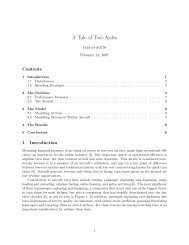Neural Models of Bayesian Belief Propagation Rajesh ... - Washington
Neural Models of Bayesian Belief Propagation Rajesh ... - Washington
Neural Models of Bayesian Belief Propagation Rajesh ... - Washington
Create successful ePaper yourself
Turn your PDF publications into a flip-book with our unique Google optimized e-Paper software.
11.4 Results 247<br />
Nonlinear Spiking Model<br />
The motion detection task can also be solved using a nonlinear network with<br />
spiking neurons as described in section 11.3.3. A single-level recurrent network<br />
<strong>of</strong> 30 neurons as in the previous section was used. The feedforward weights<br />
were the same as in figure 11.4B. The recurrent connections directly encoded<br />
transition probabilities for leftward motion (see figure 11.4C). As seen in figure<br />
11.6A, neurons in the network exhibited direction selectivity. Furthermore,<br />
the spiking probability <strong>of</strong> neurons reflects the probability m t i<br />
<strong>of</strong> motion direc-<br />
tion at a given location as in equation (11.39) (figure 11.6B), suggesting a probabilistic<br />
interpretation <strong>of</strong> direction-selective spiking responses in visual cortical<br />
areas such as V1 and MT.<br />
Neuron<br />
8<br />
10<br />
12<br />
Neuron<br />
8<br />
10<br />
12<br />
0.5<br />
0.4<br />
0.3<br />
0.2<br />
0.1<br />
0<br />
0.5<br />
0.4<br />
0.3<br />
0.2<br />
0.1<br />
0<br />
0.5<br />
0.4<br />
0.3<br />
0.2<br />
0.1<br />
0<br />
Rightward Motion Leftward Motion<br />
5 10 15 20 25<br />
5 10 15 20 25<br />
5 10 15 20 25<br />
A<br />
0.5<br />
0.4<br />
0.3<br />
0.2<br />
0.1<br />
0<br />
0.5<br />
0.4<br />
0.3<br />
0.2<br />
0.1<br />
0<br />
0.5<br />
0.4<br />
0.3<br />
0.2<br />
0.1<br />
B<br />
0<br />
5 10 15 20 25 30<br />
5 10 15 20 25 30<br />
5 10 15 20 25 30<br />
Figure 11.6 Responses from the Spiking Motion Detection Network. (A) Spiking responses<br />
<strong>of</strong> three <strong>of</strong> the first 15 neurons in the recurrent network (neurons 8, 10, and 12).<br />
As is evident, these neurons have become selective for rightward motion as a consequence<br />
<strong>of</strong> the recurrent connections (= transition probabilities) specified in Figure 11.4C.<br />
(B) Posterior probabilities over time <strong>of</strong> motion direction (at a given location) encoded<br />
by the three neurons for rightward and leftward motion.<br />
11.4.2 Example 2: <strong>Bayesian</strong> Decision-Making in a Random-Dots Task<br />
To establish a connection to behavioral data, we consider the well-known random<br />
dots motion discrimination task (see, for example, [41]). The stimulus<br />
consists <strong>of</strong> an image sequence showing a group <strong>of</strong> moving dots, a fixed fraction<br />
<strong>of</strong> which are randomly selected at each frame and moved in a fixed direction<br />
(for example, either left or right). The rest <strong>of</strong> the dots are moved in
















